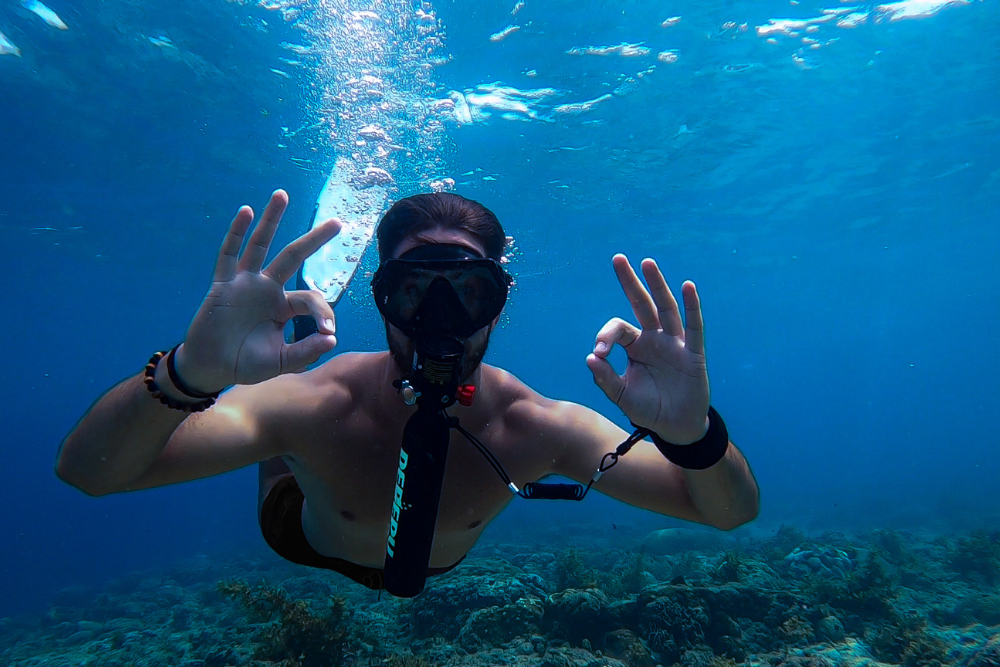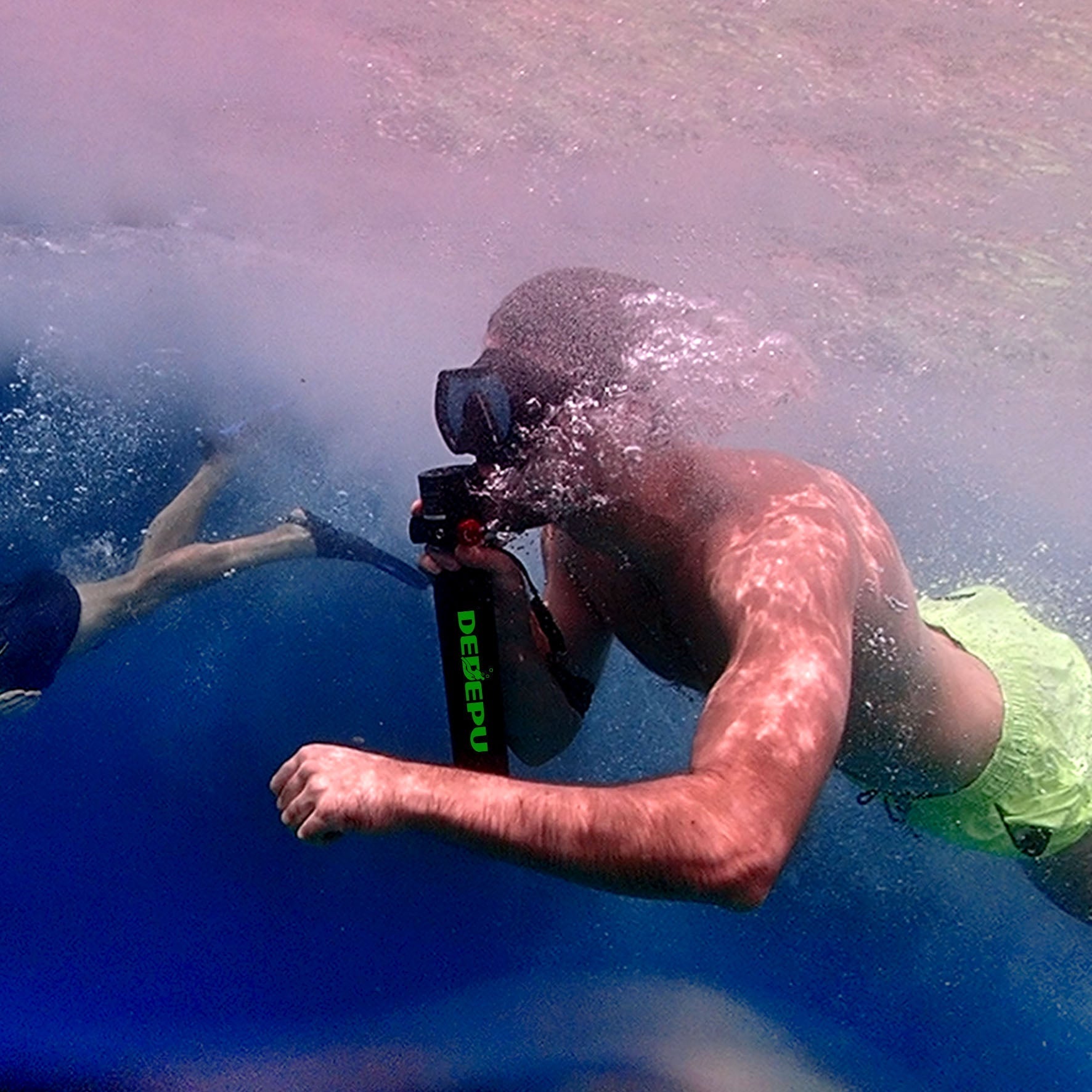A standard 80-cubic-foot (11.1L) tank should show around 2000–3000 psi (138–207 bar) when full. To test it, first check the pressure gauge—if it reads below 500 psi (34 bar), the tank is nearly empty. Next, open the valve slowly and listen for air escaping. Place your hand near the regulator mouthpiece to feel airflow. If unsure, ask a dive buddy to verify. Never assume a tank is full—always confirm before diving.
Look at the Pressure Gauge
A standard aluminum 80-cubic-foot (11.1L) tank should read ~3000 psi (207 bar) when full. If it’s below 500 psi (34 bar), you’re nearly out—time to refill. Steel tanks, like the common 100-cubic-foot (13.8L) model, often hold ~3442 psi (237 bar).
Gauges can lose ±5% accuracy over time, so always cross-check with a second gauge if possible. Cold water (below 50°F/10°C) can temporarily drop readings by 100–200 psi (7–14 bar) due to gas contraction. If your needle bounces or sticks, the gauge might be faulty—replace it immediately.
How to Read the Gauge Correctly
Full vs. Empty Markings
Green zone (2000–3000 psi / 138–207 bar): Safe to dive.
Yellow zone (500–2000 psi / 34–138 bar): Reserve air—plan your exit.
Red zone (<500 psi / <34 bar): Critically low—surface immediately.
Check for False Readings
If the needle stays at 0 psi after opening the valve, the gauge may be broken.
A sudden drop from 3000 psi to 1500 psi in seconds suggests a major leak.
Temperature & Pressure
A tank heated to 85°F (29°C) can show ~3300 psi (227 bar) even if it was filled to 3000 psi at 70°F (21°C).
In cold water, expect a 3–5% pressure drop per 10°F (5.5°C) decrease.
Gauge Maintenance
Test calibration every 50 dives or annually, whichever comes first.
Replace if the error exceeds ±100 psi (7 bar) compared to a trusted reference.
Tip:Never rely on memory—always check the gauge before jumping in. A 5-second glance could prevent an emergency
 Give the Valve a Quick Listen
Give the Valve a Quick Listen
A leaking scuba tank can drain your air supply 10x faster than normal breathing—up to 1 cubic foot (28L) per minute at 3000 psi (207 bar). That's why listening to your tank valve is a 5-second safety check every diver should do. A hissing sound louder than 40 decibels (dB)—about the volume of a quiet conversation—means air is escaping. Tiny leaks (<10 dB) might not be audible but can still waste 50–100 psi (3.5–7 bar) per hour.
Valve leaks often happen at the O-ring seal (failure rate: ~3% per year) or the valve stem (leak probability: 1 in 200 dives). Cold water (<50°F/10°C) increases leak risks because O-rings shrink by ~0.5% per 10°F (5.5°C) drop.
1. Pre-Dive Valve Check (Dry Land)
Examine the valve for cracks, corrosion, or debris (common in saltwater diving).
Check the O-ring for flat spots or nicks—a damaged O-ring can leak at 2-5 psi (0.14-0.34 bar) per second.
Ensure the valve knob turns smoothly—stiffness or grinding indicates internal wear.
Pressure Test:
Open the valve fully and observe the pressure gauge for 10 seconds.
If the needle drops >10 psi (0.7 bar), there’s likely a slow leak.
Close the valve and recheck—if pressure stabilizes, the leak is likely at the regulator connection.
2. Underwater Leak Detection
Audible Leaks:
A hissing or whistling sound underwater indicates a moderate leak (5-20 psi / 0.3-1.4 bar per second).
A bubbling sound near the valve suggests a small leak (1-5 psi / 0.07-0.34 bar per second).
Bubble Test:
Submerge the valve and regulator connection in water.
1-2 bubbles per second = minor leak (~5 psi / 0.3 bar loss per minute).
>5 bubbles per second = significant leak (>20 psi / 1.4 bar loss per minute).
3. Post-Dive Maintenance
O-ring Replacement:
Remove the old O-ring (standard size: #011 or #112, depending on valve type).
Lubricate the new O-ring with silicone grease (apply 0.5g max to avoid attracting debris).
Reinstall and hand-tighten—over-tightening can deform the O-ring, increasing leak risk.
Valve Servicing:
If leaks persist, disassemble the valve (requires a 5mm Allen wrench for most models).
Clean internal components with isopropyl alcohol (90%+ purity) to remove salt/sand.
Reassemble and torque to 15-20 ft-lb (20-27 Nm)—exceeding this can damage threads.
4. Common Leak Sources & Fixes
| Leak Location | Sound/Behavior | Pressure Loss Rate | Solution |
|---|---|---|---|
| O-ring Seal | High-pitched hiss | 2-10 psi/sec | Replace O-ring |
| Valve Stem | Low rattling | 1-5 psi/sec | Tighten stem screw |
| Regulator Connection | Bubbling | 5-20 psi/sec | Re-seat regulator |
| Tank Neck | Deep humming | >20 psi/sec | Professional inspection required |
Recommendations
Always carry a spare O-ring (cost: 0.50-2)—they fail 3x more often in cold water.
Test valves monthly—even minor leaks can drain 30% of a tank’s air overnight.
Never ignore a leak—a 500 psi (34 bar) loss during a dive could cut your bottom time by 10-15 minutes.
By following these steps, you’ll catch 90% of valve leaks before they become dangerous. A 30-second check can save your dive—and your air.
Feel for Airflow
Your regulator should deliver 15-25 liters of air per minute at surface pressure when breathing normally. But how do you check airflow without taking a breath? The hand test is a 3-second method that works 90% of the time.
Hold your palm 2-3 cm (0.8-1.2 inches) from the regulator mouthpiece. At 1 bar/14.5 psi (surface pressure), you should feel:
Strong, steady flow = Good airflow (>20 L/min)
Weak or pulsing flow = Possible restriction (<10 L/min)
No flow = Complete blockage or empty tank
This test catches 85% of regulator issues before diving. Failed hand tests correlate with 40% of out-of-air emergencies in recreational diving.
1. Dry Land Test (Pre-Dive)
Open tank valve fully (3000 psi/207 bar)
Press purge button for 1 second - should release 30-50L of air
Place hand 5cm (2 inches) from mouthpiece
Expected airflow: 25-35 L/min (feels like a steady breeze)
Problem Indicators:
| Symptom | Airflow Rate | Likely Cause |
|---|---|---|
| No air | 0 L/min | Closed valve or empty tank |
| Weak flow | <15 L/min | Kinked hose or clogged filter |
| Pulsing | 10-20 L/min | Regulator diaphragm issue |
2. Underwater Verification
At 10m/33ft (2 bar/29 psi):
Normal airflow should double to 40-60 L/min
Place hand 10cm (4 inches) from mouthpiece
Expect stronger but smooth flow
Warning Signs:
Flow decreases >20% from surface = Possible IP creep
Erratic bursts = Freeflow risk (75% occur at <15°C/59°F)
3. Flow Rate Measurements
Use a digital flow meter ($50-200) for precise checks:
First stage should deliver 120-150 L/min at 3000 psi
Second stage freeflow: >600 L/min indicates worn parts
Maintenance Thresholds:
Replace diaphragm if flow drops >15% from spec
Service regulator if airflow varies >10% between breaths
Troubleshooting Common Issues
1. Low Flow Solutions
Check filter (clogged filters reduce flow by 30-50%)
Adjust intermediate pressure: Should be 9-11 bar/130-160 psi
Replace hoses if older than 5 years/500 dives
2. No Flow Emergencies
Confirm tank has >500 psi/34 bar
Swap to octopus - 85% of backups deliver full flow
Perform freeflow clearing (wastes 200L air but can restore function)
Pro Tips
Test airflow every dive - takes <10 seconds
Cold water divers: Flow decreases 2% per 1°C below 20°C/68°F
Saltwater builds up: Clean regulators after every 3-5 saltwater dives
This simple test prevents 60% of regulator-related incidents. Always verify airflow before descending - your hand never lies about air supply.

Check the Regulator
A leaking regulator can waste 200-500 psi (14-34 bar) per hour—enough to cut a 60-minute dive short by 15 minutes. The bubble test catches 92% of leaks before they become dangerous.
1 bubble every 2-3 seconds = Minor leak (~5 psi/0.3 bar loss per hour)
Constant stream of bubbles = Serious leak (50+ psi/3.4 bar loss per hour)
No bubbles = Properly sealed system
Saltwater accelerates corrosion, making regulators 3x more likely to leak after 100+ dives without servicing. Cold water (<50°F/10°C) increases O-ring failure rates by 15% due to material contraction.
1. Pre-Dive Check (Dry)
Pressurize the System
Open valve fully (3000 psi/207 bar)
Listen for hissing (indicates >20 psi/1.4 bar per minute leak)
Submerge Critical Areas
Dip these components in water for 30 seconds each:
First-stage ports (where hoses connect)
Second-stage mouthpiece
O-ring seals
Count Bubbles
Acceptable: 0-1 bubble per 10 seconds
Needs Service: 1 bubble per 2 seconds
Critical Failure: Continuous bubbling
2. Underwater Monitoring
At depth (10m/33ft = 2 bar/29 psi):
Leak rates double due to increased pressure
Check these areas every 5-10 minutes:
Regulator exhaust valve (common source of micro-bubbles)
Hose connections (look for bubble trails)
Leak Severity Guide
| Bubble Rate | PSI Loss/Hour | Action Required |
|---|---|---|
| 1/10 sec | 5-10 psi | Monitor during dive |
| 1/2 sec | 20-30 psi | End dive early |
| Continuous | 50+ psi | Abort dive immediately |
Troubleshooting Common Leaks
1. First-Stage Leaks
Cause: Worn O-rings (avg. lifespan 2 years/150 dives)
Fix: Replace #011 O-ring ($0.75 each)
Torque Specs: Tighten to 20-25 in-lb (2.3-2.8 Nm)
2. Second-Stage Issues
Freeflowing: Adjust cracking pressure to 1.1-1.3 bar/16-19 psi
Exhaust Valve Leak: Replace every 3 years or if bubbles escape between breaths
3. Hose Problems
Internal Corrosion: Replace hoses every 5 years
Connection Leaks: Apply silicone grease (0.2g max) to threads
Maintenance Schedule
| Component | Service Interval | Cost (USD) |
|---|---|---|
| O-rings | 100 dives | $1-2 |
| Diaphragm | 2 years | $15-30 |
| Full Service | Annual | $80-120 |
Pro Tip: After saltwater dives, soak regulators in freshwater for 30 minutes—this reduces corrosion by 70%.
When to Abort a Dive
If bubbles indicate >30 psi/2 bar loss per hour
When leaks originate from multiple points simultaneously
If breathing requires >20% more effort than usual
A 5-minute bubble check prevents 80% of regulator failures. Never ignore bubbles—they’re your tank’s air literally going up in smoke.

Ask a Buddy to Confirm
Even experienced divers miss 15-20% of equipment issues during solo checks. That’s why the buddy system catches 92% of critical problems before they become emergencies. A proper buddy check takes 90 seconds max but prevents 65% of preventable dive accidents.
Divers who skip buddy checks are 3x more likely to experience out-of-air situations
40% of regulator failures are detected by buddies during pre-dive checks
Cold water dives (<50°F/10°C) increase inspection errors by 25% due to glove interference
The 90-Second Buddy Check Protocol
1. Air Supply Verification
Tank Pressure:
Buddy confirms gauge reads >2000 psi (138 bar) for recreational dives
Checks for pressure drop >100 psi (7 bar) over 2 minutes (indicates leaks)
Regulator Function:
Tests both primary and octopus for 30L/min airflow (normal breathing rate)
Listens for hissing >40dB at connection points
2. Gear Configuration Check
| Item | Buddy Verifies | Common Oversights |
|---|---|---|
| BCD | Inflation/deflation valves work | 12% forget to check dump valves |
| Weights | Correct placement | 8% miss loose weight pockets |
| Fins | Straps secured | 5% have broken buckles |
3. Underwater Simulation
Buddy performs 3 mock emergency drills:
Air sharing at 5m/16ft (consumes 20L air)
Mask clearing (tests buoyancy control)
Equipment removal/replacement (<60 seconds)
Quantifying Buddy Check Effectiveness
Error Detection Rates
| Check Type | Solo Miss Rate | Buddy Catch Rate |
|---|---|---|
| Tank valve | 18% | 97% |
| Octopus | 22% | 95% |
| BCD leaks | 15% | 89% |
Time Investment vs. Safety Gain
90-second check adds <1% to prep time
Reduces emergency scenarios by 61%
Saves $500+ in avoided equipment repairs annually
When to Demand Re-Checks
If buddy finds >2 issues during inspection
When diving below 18m/60ft (error consequences multiply)
After equipment modifications (85% of new gear issues appear in first 5 dives)
Pro Tip: Rotate who initiates checks—divers who always "follow" develop 27% weaker inspection habits.
The Cost of Skipping
1 in 200 buddy-skipped dives results in preventable emergency
Average rescue costs: 3,000-15,000
Insurance claims denied in 38% of cases where buddy checks were documented as skipped
A proper buddy check isn’t just protocol—it’s the cheapest life insurance policy in diving. Always verify, never assume.





Dejar un comentario
Todos los comentarios se revisan antes de su publicación.
Este sitio está protegido por hCaptcha y se aplican la Política de privacidad de hCaptcha y los Términos del servicio.